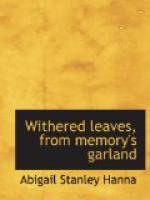Crossing the stream upon the remains of an old dam, and passing the extent of meadow, we entered upon a rich clover field, adjoining which was the corn field, that in autumn used to be laden with yellow corn and golden pumpkins. Contiguous to this was a delightful grove composed of thrifty walnut trees, carefully cleared from under brush and covered with verdant grass, and ornamented here and there with a grassy hillock, that rendered it a pleasant retreat from the scorching rays of the summer sun. The air was filled with the notes of the feathered songsters that built their nests and warbled in their branches, mingling their music with the rustling leaves and the murmur of the distant spring that rippled near, for a gradual descent brought us down to the spring lot, which, with the grove and the swamp that lay below, was used for pasturage. But let us pause and take a survey of its present appearances. The beautiful trees have all fallen before the woodman’s axe, not one remaining as a link with their past history; the old fence has been removed that divided it from the cornfield, and surrounded by a new and beautiful one, it now forms a part of a commodious Cemetery, is laid out into tasteful lots as the last resting place of the dead.
Sweet spot; methinks it is meet for the weary children of earth to slumber in this quiet place.
At its foot gurgles the quiet winding stream, and far away comes the din and hum of active life, thronged with the busy crowd whose restless feet are bearing them swiftly on to the end of life’s journey, where they must resign the cumbrous load and “join the pale caravan in the realms of shade.”
Descending from the grove on the western side, was a low, swampy piece of ground, that had never yielded to cultivation, where we sometimes used to jump from one hillock to another in search of swamp pinks and cheeses which were to be found there in great abundance.
It was ever covered with low brush, of natural growth, and apparently no change had passed over it from its creation, save the natural springing up and decaying of its productions. And so, almost fifty years ago, we left it, but how does it meet us upon our return? Art has touched it with her handy work. It has been drained; the brush cut from its surface, rich loam carted upon it, and now it presents the appearance of a well cultivated garden, is covered with luxuriant grass, and staked out into yards for the accommodation of families who wish to lie down side by side, in the sleep of death. Many, already, are beautified with flowers and shrubbery; and in some, already arises the marble slab, pointing to the place where some weary pilgrim reposes, free from all the earth calls good or great; for this, too, is enclosed in the Cemetery.
But passing the entrance into the Cemetery, we will pass back by a circuitous route, to the dear old home. The road, the hills, the rocks, the trees, and many of the buildings are the same; but, oh, how many and varied are the changes that strike the eye, and awaken in the breast ten thousand bewildering remembrances. Truly has the human heart been compared to a many stringed instrument, giving diversity of sound as it is swept by different winds.




